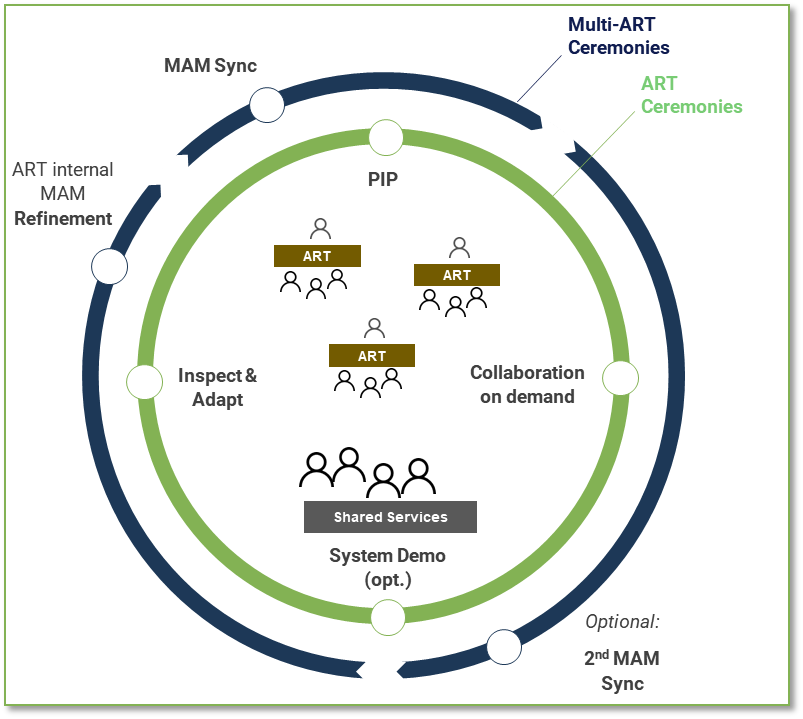Multi-ART Management: Challenges in the management of different agile organizational units
Currently, many companies have converted their organizational structure and processes in parts or comprehensively to an agile model in order to achieve more flexibility and a value-maximizing focus of budgets and resources. Our experience is that at a certain scale of scaled agility, some particular challenges and pitfalls arise.
In particular, planning for dependencies and reliable delivery of mutual provisioning services between larger scaled agile organizational units create delays and inconsistencies. This can be remedied by introducing SAFe Solutions or Solution Trains. However, to avoid a costly and comprehensive implementation of these Solutions, we have derived a leaner NTT DATA method Multi-ART Management - MAM for short.
Based on the SAFe term Agile Release Train (ART) for scaled agile units, MAM provides a structured solution approach for managing overarching dependencies while maintaining the greatest possible autonomy of the individual ARTs.
The management of dependencies in scaled agile working methods must answer one question in particular: who must schedule what for which time period and how precisely must the functional, technical description for this be available considering the respective planning ceremonies. Experience shows that even small differences in the processes, the cadences and the tools used can lead to seemingly insurmountable hurdles. In practice, this results in the problem that many teams do not plan a buffer for additional services at the beginning of their iterative planning of the upcoming sprints or do not recognize which dependencies must be taken into account for the upcoming iteration with which higher priority in terms of capacity.
Reasons for NTT DATA's Multi-ART Management Approach
To address the above challenges, many frameworks already propose cross-ART layers (e.g. Solution in the SAFe framework). However, we observe that these layers are very complex to implement and thus time and cost intensive. In addition, these solutions only contain those ARTs that are assigned to a value stream. In practice, the question of how ARTs or several teams solve dependencies and cooperate that are not connected in the classical sense of a solution according to value streams often remains open.
For this reason, with our MAM approach we pick out the best practices and most important elements of a Solution and implement only those mechanisms, ceremonies or roles that we consider relevant from practice in order to create a standard for each ART - regardless of the organizational assignment. And in doing so, keep the necessary measures for overarching standardization of cadences, tools and processes low.
What is Multi-ART Management?
MAM is a mechanism to optimize the flow of cross-ART dependency management. Our intention is always the realization of quick wins and the creation of simple and standardized structures.

In this context, the MAM is to be understood as a link between the portfolio and the operationalization of agile teams in order to stay in line with the already running agile processes of a company.
At the core of the MAM approach are the lean MAM ceremonies, which are a wraparound cycle complementary to the already established ceremonies of an ART. A few weeks before a PI planning, those MAM ceremonies take place to synchronize all ARTs followed by an ART-internal refinement to achieve the level of detail required for scheduling.
NTT DATA's offering for the Multi-ART Management Approach
With Multi-ART Management, you receive a solution approach that has been tried and tested with numerous customers. Experienced consultants adapt it to the individual needs of your ARTs. Together with your executives we define the way of your individual MAM adaptation, so that your Multi-ART Management solution becomes an integral part of your agile methodology.
To this end, we bring successfully established best practices from other projects and provide a comprehensive toolkit with recommended standards. This contains among others:
- Road to MAM checklist for each organizational unit.
- Implementation roadmap
- Guidelines for facilitating MAM ceremonies
- (E)RASCI matrix for clarifying tasks and responsibilities
- MAM Wiki for company-wide communication of the standardized MAM approach
- Documentation of tickets/items in collaboration tools for uniform evaluation
- APMO concept for project coordination
- Examples of transparent MAM dashboards
This MAM toolkit provides you a fixed and proven framework for implementation. Through this framework, the implementation can be customized without ignoring the need for ART overarching standards.
Outlook and adaptability to other organizational models
We see our MAM primarily as a mechanism that can be applied flexibly. As a result, our approach not only enables dependency management of agile organizational units but can also be extended to hybrid organizational models. We often experience the case where entire organizational units are already working in agile cycles, but others are working with classic project management methods and structures. Even in this particular context, MAM can integrate cross-cutting processes for alignment, enabling its units to manage dependencies.
For this reason, we can also recommend our Multi-ART management approach in terms of our NTT DATA Liquid Enterprise Initiative - i.e. combining agile with classic structures.
Author: Sven Bauer, Senior Consultant Transformation Management, NTT DATA DACH

